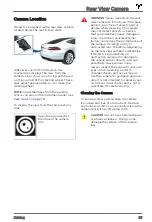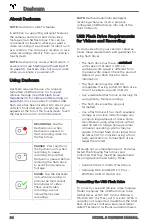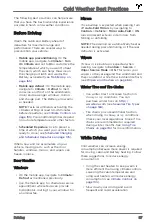
Features
These safety features are available on all
Model S equipped with Autopilot
components:
• Lane Assist (see
• Collision Avoidance Assist (see
).
• Speed Assist (see
).
• Auto High Beam (see
).
These Autopilot convenience features are
designed to reduce driver workload:
• Traffic-Aware Cruise Control (see
Aware Cruise Control on page 92
• Autosteer (see
• Auto Lane Change (see
• Autopark (see
• Summon (see
)
• Smart Summon (
)
• Navigate on Autopilot (see
)
NOTE:
Depending on market region, options
purchased, and software version, your
vehicle may not be equipped with all
Autopilot features.
You can enable/disable some of these
features and in some cases, control how they
work. To access settings, touch
Controls
>
Autopilot
.
Drive to Calibrate Cameras
Model S must maneuver with a great deal of
precision when Autopilot features are being
used. Therefore, before some features (for
example, Traffic-Aware Cruise Control or
Autosteer) can be used for the first time or
after certain Service repairs, the cameras
must complete a self-calibration process. For
your convenience, a progress indicator is
displayed on the instrument panel.
Calibration typically completes after driving
32-40 km, but the distance varies depending
on road and environmental conditions.
Driving on a straight road with highly-visible
lane lines allows Model S to calibrate quicker.
When calibration is complete, the Autopilot
features are available for use. Contact Tesla
only if your Model S has not completed the
calibration process after driving 160 km.
NOTE:
If you attempt to use a feature that is
not available until the calibration process is
complete, the feature will not be enabled and
the instrument panel displays a message.
NOTE:
Model S must repeat the calibration
process if the cameras are serviced by Tesla,
and in some cases, after a software update.
NOTE:
The self-calibration drive process is
only applicable to Model S vehicles built after
approximately October 12, 2016.
Limitations
Many factors can impact the performance of
Autopilot components, causing them to be
unable to function as intended. These include
(but are not limited to):
• Poor visibility (due to heavy rain, snow,
fog, etc.).
• Bright light (due to oncoming headlights,
direct sunlight, etc.).
• Damage or obstructions caused by mud,
ice, snow, etc.
• Interference or obstruction by object(s)
mounted onto the vehicle (such as a bike
rack).
• Obstruction caused by applying excessive
paint or adhesive products (such as
wraps, stickers, rubber coating, etc.) onto
the vehicle.
• Narrow or winding roads.
• A damaged or misaligned bumper.
• Interference from other equipment that
generates ultrasonic waves.
• Extremely hot or cold temperatures.
About Autopilot
90
MODEL S OWNER'S MANUAL
















































